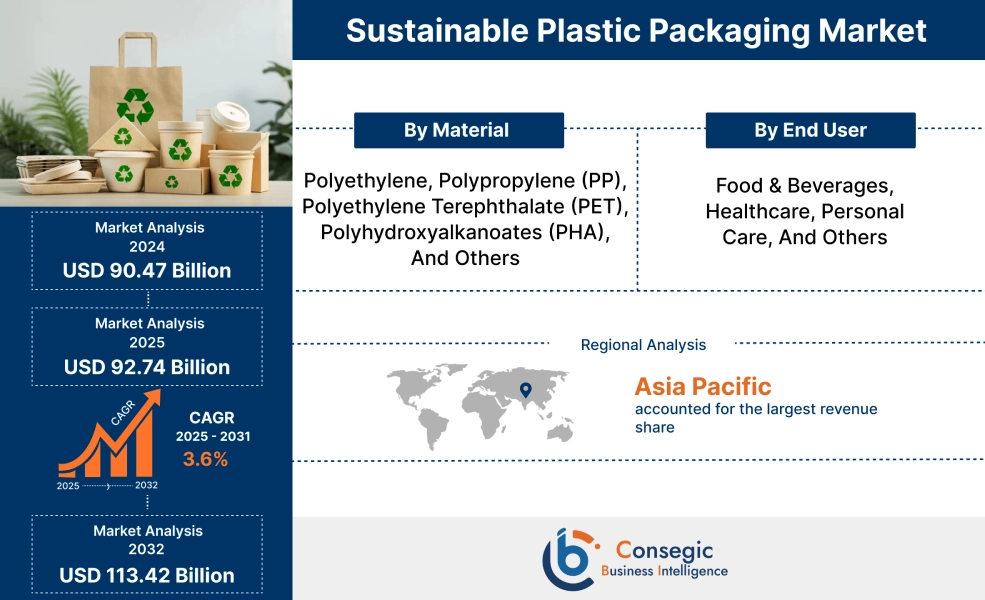- Summary
- Table Of Content
- Methodology
Sustainable Plastic Packaging Market Size:
Sustainable plastic packaging market size is estimated to reach over USD 116,767.11 Million by 2031 from a value of USD 88,333.33 Million in 2023, growing at a CAGR of 3.6% from 2024 to 2031.
Sustainable Plastic Packaging Market Scope & Overview:
Sustainable plastic packaging refers to packaging made from renewable resources like vegetable oils, sugarcane, and others to reduce environmental impacts. There are various products of this packaging such as plastic containers, bottles, bags, and others. This packaging has applications in various industries such as food and beverages, automotive, healthcare, and others. There are various benefits of this packaging such as reducing waste, being environmentally friendly, cost-efficiency, and more. Various types of materials like polyethylene, polypropylene (PP), polyethylene terephthalate (PET), polyhydroxyalkanoates (PHA), and others are used in this type of packaging. Further, in material, polyethylene is widely used due to its versatility and recyclability. United States government implemented initiatives like the National Strategy to Prevent Plastic Pollution. It aims to reduce pollution from plastic production and ban on single use-plastic packaging, thereby promoting a sustainable plastic packaging market.
Sustainable Plastic Packaging MarketDynamics - (DRO) :
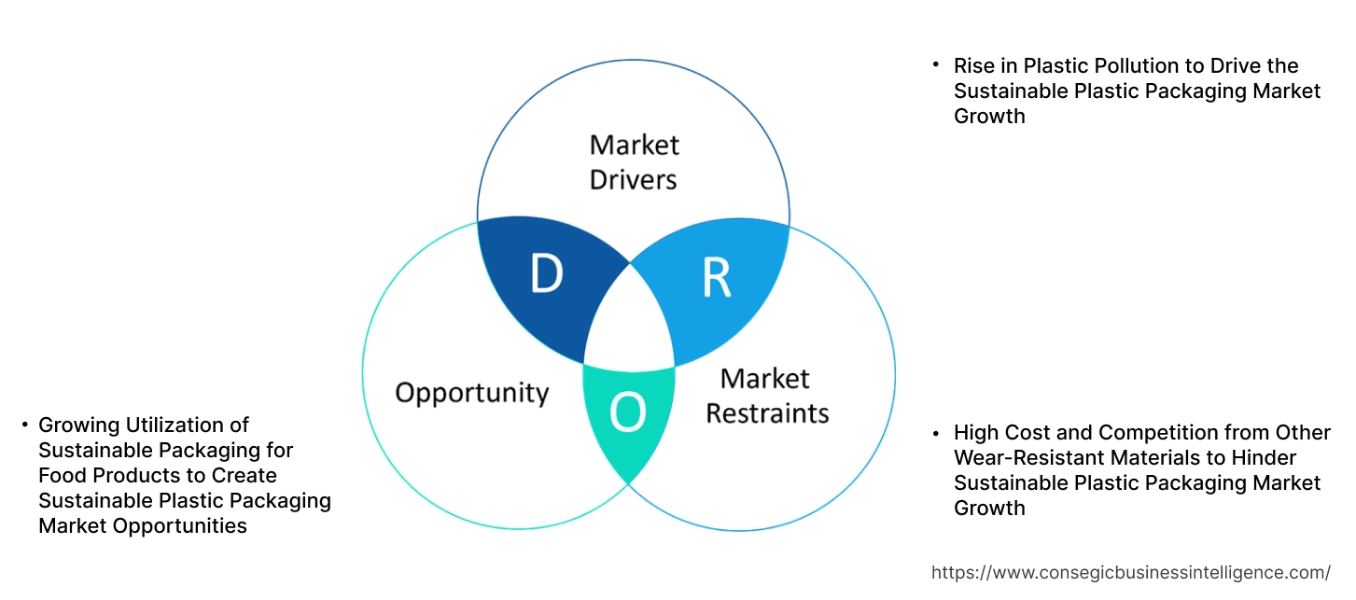
Key Drivers:
Implementation of Stringent Regulations for Plastic Packaging is Fueling Sustainable Plastic Packaging Market Growth
U.S. government regulations like the Packaging and Packaging Waste Regulation (PPWR), Extended Producers Responsibility (EPR), and others play a pivotal role in implementing sustainable plastic packaging to reduce plastic waste. Extended Producers Responsibility (EPR) is a regulation in Plastic Waste Management Rules, 2016. According to this regulation, it is the responsibility of producers, importers, and brand owners to ensure the processing of their plastic packaging waste through recycling, reuse, or end-of-life disposal. Countries like the United States, India, and others are implementing the Extended Producers Responsibility regulation to reduce plastic waste, thereby propelling the sustainable plastic packaging market.
- According to the India Plastic Pact, in February 2022, India implemented new comprehensive guidelines on EPR for plastic packaging, strengthening the existing rules. The guidelines mandated the usage of recycled plastic content in packaging along with the ban on single-use plastics in selected communities. This is fueling the growth of the market by promoting eco-friendly practices.
Thus, government regulations such as Extended Producers Responsibility are fueling sustainable plastic packaging market expansion through sustainable practices and a circular economy.
Growing Bioplastics Production is Driving Sustainable Plastic Packaging Market Expansion.
Bioplastics are a type of plastic derived from renewable sources such as sugarcane, vegetable oils, and others. They play a major role in sustainable plastic packaging due to its lower environmental impact. With increasing consumer awareness about eco-friendly practices, there is a significant shift towards bioplastic production. Bioplastics such as polyhydroxyalkanoates (PHA), polylactic acid (PLA), and others are widely used in the sustainable packaging market. Further, it is widely used in industries like food and beverages, healthcare, personal care, and others.
- In 2023, according to European Bioplastics, global bioplastics production is set to increase significantly from around 2.18 million tonnes in 2023 to approximately 7.43 million tonnes in 2028. This will lead to the proliferation of the sustainable plastic packaging market, as bioplastics are majorly used for packaging applications.
Thus, growing bioplastics production is creating sustainable plastic packaging market demand due to consumer awareness and lower environmental impact.
Key Restraints :
High Cost Associated with Bioplastic Production is Constraining the Market Growth
High cost is a significant constraint in the sustainable plastic packaging market, due to the initial investment required for adopting sustainable packaging solutions. The cost of this type of packaging is higher as compared to single use plastic packaging due to advanced manufacturing technologies, higher transport, and maintenance. This type of packaging, especially using bioplastics requires advanced technologies and bio-based feedstock which is more expensive than traditional plastic. Bioplastics like polyhydroxyalkanoates (PHA) and polylactic acid (PLA) involve advanced biochemical processes like fermentation and polymerization. This results in a higher cost of polyhydroxyalkanoates (PHA) and polylactic acid (PLA) as compared to conventional polyethylene plastic.
Thus, high costs are restraining the market due to the requirement for advanced manufacturing technologies, higher transport, and maintenance.
Future Opportunities :
Government Initiatives are expected to create Sustainable Plastic Packaging Market Opportunities
The growing emphasis on sustainability and waste reduction is significantly influencing the market trends across industries. Government organizations like the United States Environmental Protection Agency (EPA) implemented the National Strategy to Prevent Plastic Pollution. It provides an ambitious, equitable approach to reducing and recovering plastics, preventing plastic pollution, and promoting a sustainable plastic packaging market.
- In 2024, S. EPA implemented the National Strategy to Prevent Plastic Pollution. Its main objective is to address plastic pollution throughout the lifecycle of plastic products. It aims to reduce pollution from plastic production, and ban on single plastic packaging, thereby promoting a sustainable plastic packaging market.
Thus, this government initiative such as the National Strategy to Prevent Plastic Pollution is creating sustainable plastic packaging market opportunities by reducing plastic pollution and ban on single-use plastic packaging.
Sustainable Plastic Packaging Market Segmental Analysis :
By Material:
By material, the market is divided into polyethylene, polypropylene (PP), polyethylene terephthalate (PET), polyhydroxyalkanoates (PHA), and others.
Trends in the Material:
- According to sustainable plastic packaging market trends, polyethylene is widely used for food product packaging due to its versatility and recyclability.
- The use of Polyhydroxyalkanoates is increasing due to its natural decomposition and consumer demand for eco-friendly alternatives as per the latest trends.
The polyethylene accounted for the largest market share of 38.15% in the year 2023..
- Polyethylene is a key material in the market due to its versatility and recyclability.
- It is derived from renewable resources such as sugarcane, making it an eco-friendly alternative that reduces dependency on fossil fuels.
- It is derived from renewable resources such as sugarcane, making it an eco-friendly alternative that reduces dependency on fossil fuels.
- Many food and beverage companies like Lamb Weston and Mondelēz International are investing in sustainable plastic packaging using bio-polyethylene, further fueling the market.
- For instance, in 2024, SABIC, Lamb Weston, and OPACKGROUP partnered to create sustainable packaging made with bio-polyethylene. This will lead to the bio-circular retail packaging solution for Lamb Weston’s frozen potato products, further fueling the market.
- Thus, the use of polyethylene is growing in the market due to its sustainability as per current trends.
The polyhydroxyalkanoates (PHA) are expected to grow at the fastest CAGR over the forecast period.
- Polyhydroxyalkanoates (PHA) are rapidly used in the sustainable plastic packaging market due to their superior environmental benefits.
- It is derived from microbial fermentation of renewable feedstock or organic waste. It is 100% biodegradable and breaks down naturally in soil, water, and even marine environmental conditions.
- It is used in a wide range of applications such as food packaging, agricultural films, healthcare products, and others.
- The non-toxic nature of PHA and its ability to decompose naturally aligned with consumer demand for eco-friendly alternatives and stringent environmental regulations.
- Further, investment in research and development is rapidly improving the scalability and affordability of PHA.
- Thus, Polyhydroxyalkanoates is expected to be rapidly used in this type of packaging due to its environmental benefits and government support.
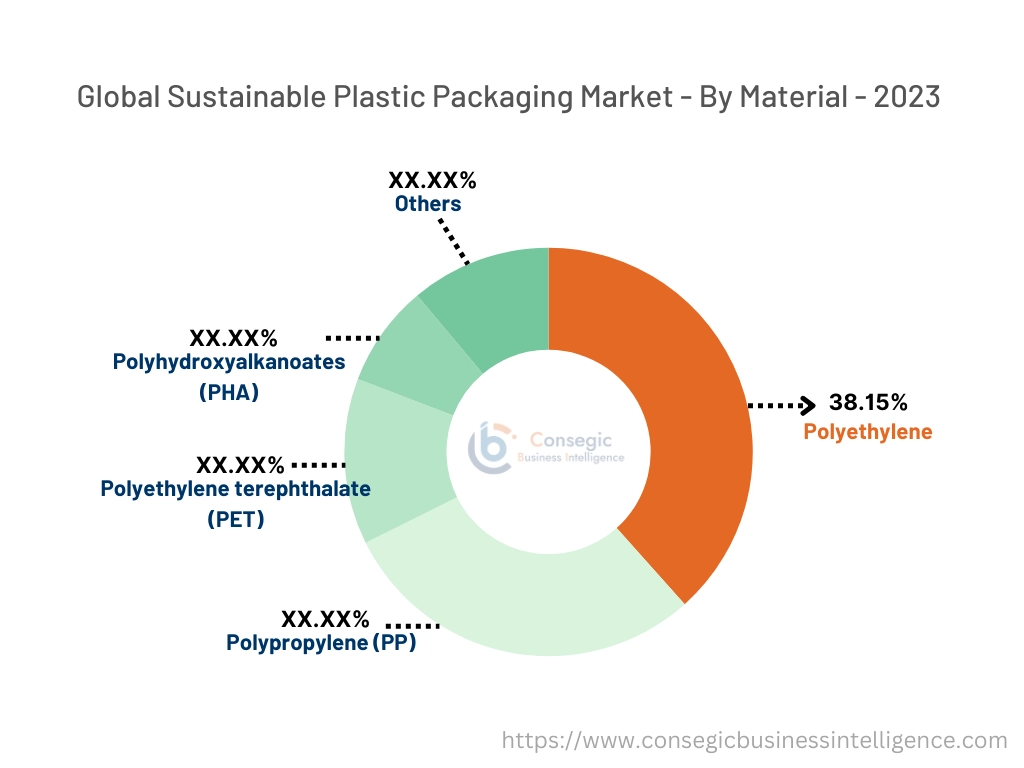
By End-Use Industry:
By end-use industry, the market is divided into food and beverages, healthcare, personal care, and others.
Trends in End-Use Industry:
- According to sustainable plastic packaging market trends, this type of packaging is widely used for packaging food products to ensure quality and reduce plastic waste.
- Sustainable plastic packaging is being rapidly used in healthcare to reduce environmental impact and to extend the shelf life of products as per the latest trends.
Sustainable plastic packaging is being rapidly used in healthcare to reduce environmental impact and to extend the shelf life of products as per the latest trends.
- Food and beverages dominate the market due to its extensive use of sustainable plastic pallets, crates, and containers for food products.
- It heavily relies on sustainable plastic packaging to ensure product safety, maintain quality, and reduce waste across supply chains.
- Many food and beverage companies are using this type of packaging for the packaging of their products promoting sustainable and eco-friendly practices.
- For instance, in 2022, Mondelēz International launched Cadbury dairy milk packaging supplied in partnership with Amcor in the United Kingdom & Ireland using certified recycled plastic. This leads to Cadbury Dairy Milk and Cadbury Mini Snowballs 110g sharing bars packaging with 30% recycled plastic, leading to market proliferation in the European region.
- Thus, sustainable plastic packaging is widely used in food and beverages driven by sustainability and eco-friendly practices.
Healthcare is expected to grow at the fastest CAGR over the forecast period.
- The use of sustainable plastic packaging in healthcare is growing to reduce environmental impact and stringent regulatory standards required for the packaging of medical products.
- The packaging of medical devices, pharmaceuticals, and healthcare consumables is increasingly using this type of packaging.
- Further, the market is propelled by increasing demand for protective packaging solutions that ensure product safety, extend shelf life, and maintain product integrity in healthcare.
- Materials like bio-polypropylene, polyhydroxyalkanoates, and others are being considered due to their biodegradability and lower carbon footprints in healthcare.
- Hence, the transition to sustainable plastic packaging in healthcare is growing driven by growing regulatory pressures and the environmental impact of plastic waste.
Regional Analysis:
The regional segment includes North America, Europe, Asia Pacific, the Middle East and Africa, and Latin America.
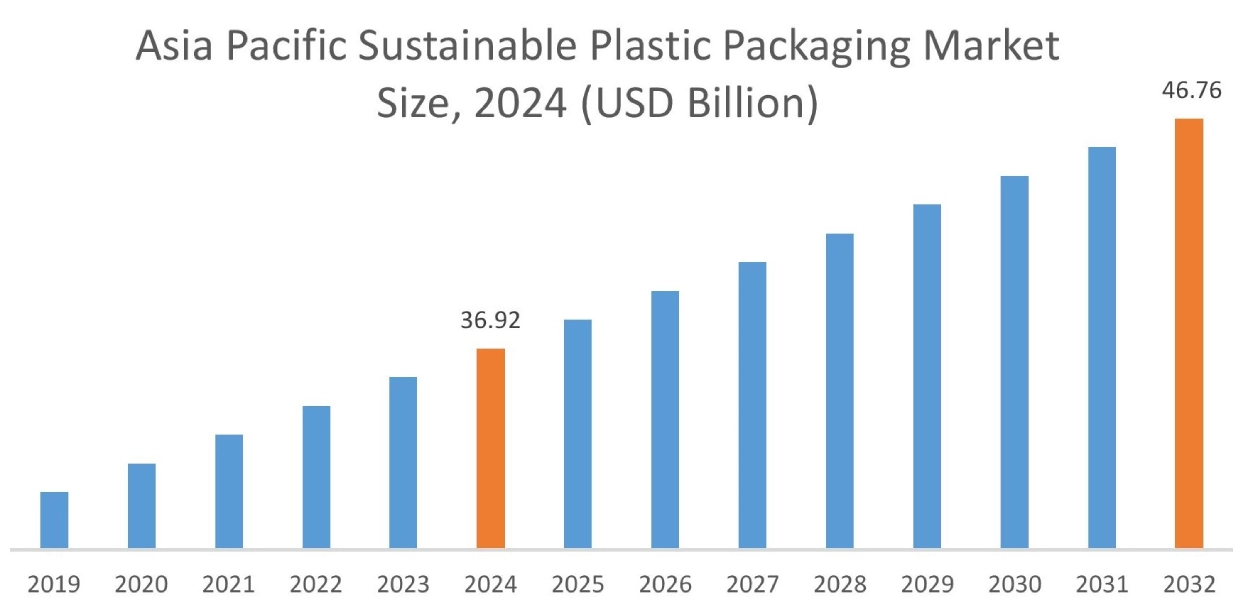
In 2023, Asia-Pacific accounted for the highest market share at 40.76% and was valued at USD 36,004.67 Million and is expected to reach USD 47,676.01 Million in 2031. In Asia-Pacific, China accounted for the highest market share of 24.15% during the base year of 2023. As per market analysis, the Asia-Pacific sustainable plastic packaging market share is driven by government initiatives that promote sustainable practices. Countries like China, India, and Japan are major contributors to this market, by promoting sustainable practices and a circular economy. Governments in these countries have also banned single-use plastic packaging and have implemented Extended Producers Responsibility regulations promoting this type of packaging. Further, chemical companies like SABIC are investing in recycled plastic in India, further propelling the market.
- In 2024, SABIC partnered with Pashupati Group for plastic recycling in India. It includes converting plastic waste into pyrolysis oil for use as feedstock in the production of SABIC’s certified circular polymers. This feedstock will be used in the production of bioplastics, further fueling the sustainable plastic packaging market.
Thus, Asia-Pacific is dominating the market, supported by government initiatives and technological advancements as per the market analysis.
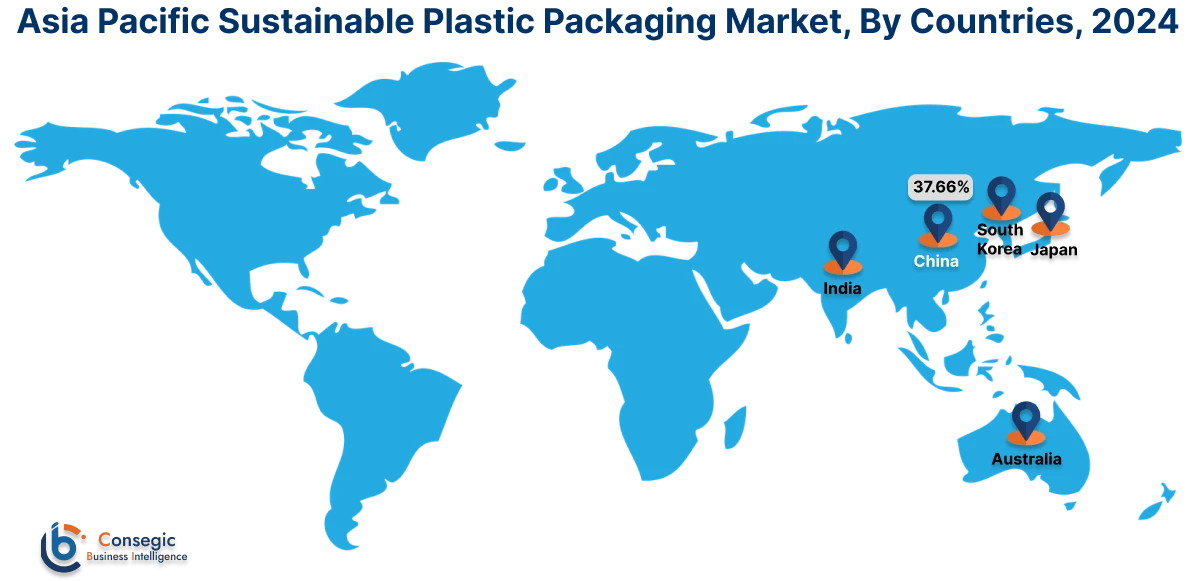
Europe is expected to witness the fastest CAGR over the forecast period of 4.1% during 2024-2031. According to sustainable plastic packaging market analysis, the European market for this type of packaging is growing significantly. It is primarily driven by stringent environmental regulations and a strong emphasis on sustainability. The European Union’s commitment to a circular economy, supported by initiatives like the EU-single-use plastic Directive, has encouraged industries to adopt this type of packaging solution. Key sectors such as food and beverage, and automotive are leading this shift, supported by consumer preferences for eco-friendly and sustainable packaging. Additionally, European startups like Hipli and Re-zip are partnering with e-commerce giant Amazon to provide sustainable plastic packaging in the E-commerce business. Countries like Germany, France, and the Netherlands are pioneers in this market leveraging advanced recycling infrastructure and innovation in this type of packaging. Also, the European government is promoting sustainable practices through Registration, Evaluation, Authorization, and Restriction of Chemicals (REACH) regulation, further fueling the market. Thus, Europe is expected to emerge rapidly in the global sustainable plastic packaging market, through technological advancements and sustainable solutions.
According to market analysis, the sustainable plastic packaging market share of North America is experiencing significant growth, driven by increasing awareness of sustainability, stringent environmental regulations, and advancements in packaging technologies. The region’s well-established supply chain infrastructure and technological innovation are further fueling this market. Countries like the United States, Mexico, and Canada are key contributors to this market, by promoting sustainable practices and a circular economy. Further, government organizations like the United States Environmental Protection Agency (EPA) are implementing the National Strategy to Prevent Plastic Pollution, further propelling the market. Regional economies are promoting circular economy practices along with advanced recycling technologies in bioplastics production, which has further increased the sustainable plastic packaging market demand in this region.
The sustainable plastic packaging market in the Middle East and Africa region is experiencing steady growth, driven by growing industrialization, government initiatives to reduce waste, and rising awareness about sustainability. Industries like food and beverage, logistics, and retail are embracing this type of packaging in the Middle East and Africa region. Gulf Council Countries are adopting green initiatives as part of their long-term environmental goals, further accelerating the market. The region is focusing on using biodegradable bags to sustainable plastic containers, promoting eco-friendly and sustainability practices. However, underdeveloped recycling infrastructure, high initial costs, and limited awareness in some parts of the region hinder the widespread adoption of this type of packaging in the region as per the analysis.
Latin America's sustainable plastic packaging market growth is gaining traction, driven by an increasing focus on sustainability and the adoption of eco-friendly practices by industries. Key sectors such as food and beverage, automotive, and retail are majorly contributing to this market with the use of this type of packaging solutions. Countries like Brazil, Mexico, and Argentina are leading this market due to rising consumer awareness and government regulations aimed at reducing waste. Regional economies are promoting circular economy practices and the participation of global companies is accelerating the market growth in this region. Additionally, advancements in logistics and packaging technologies, such as the Internet of Things (IoT)-enabled tracking for efficient reuse are improving the adoption rate of packaging solutions in this region as per sustainable plastic packaging market analysis.
Top Key Players & Market Share Insights:
The sustainable plastic packaging industry is highly competitive with major players providing products and services to the national and international markets. Key players are adopting several strategies in research and development (R&D) and product innovation to hold a strong position in the global market. Key players in the sustainable plastic packaging industry include-
- Amcor plc (Australia)
- AptarGroup, Inc (United States)
- Crown Holdings, Inc. (United States)
- Tetra Pak (Switzerland)
- DS Smith (United Kingdom)
- Constantia Flexibles (Austria)
- NEFAB GROUP (Sweden)
- Berry Global Inc. (United States)
- Reynolds Packaging (United States)
- Greiner Packaging (Austria)
Recent Industry Developments :
Research and Developments:
- In 2024, HydroGraph Clean Power announced a technological advancement in its sustainable plastic packaging research. It demonstrated that its FGA-1 enhances the performance of polyethylene terephthalate (PET) bottles at an ultra-low loading of just 0.006 wt-% of graphene added, which could lead to lightweighting and an overall reduction in plastic use. This will lead to the proliferation of the market by advancing the formulation of PET bottles.
Partnerships and Collaborations:
- In 2024, Bormioli Pharma & Loop Industries partnered for a packaging solution produced completely from recycled virgin-quality Loop polyethylene terephthalate (PET) resin. It will lead to pharmaceutical packaging bottles manufactured with 100% recycled virgin-quality Loop PET resin, further expanding the market.
Launches:
- In 2024,SCGC launched 100% recycled plastic packaging for skincare products.This partnership aims to help propel Thailand and ASEAN toward a low-carbon society under SCGC’s "Low Waste, Low Carbon" strategy. This will lead to the proliferation of the sustainable plastic packaging market.
Sustainable Plastic Packaging Market Report Insights :
| Report Attributes | Report Details |
| Study Timeline | 2018-2031 |
| Market Size in 2031 | USD 116,767.11 Million |
| CAGR (2024-2031) | 3.6% |
| By Material |
|
| By End-use Industry |
|
| By Region |
|
| Key Players |
|
| North America | U.S. Canada Mexico |
| Europe | U.K. Germany France Spain Italy Russia Benelux Rest of Europe |
| APAC | China South Korea Japan India Australia ASEAN Rest of Asia-Pacific |
| Middle East and Africa | GCC Turkey South Africa Rest of MEA |
| LATAM | Brazil Argentina Chile Rest of LATAM |
| Report Coverage |
|
Key Questions Answered in the Report
How big is the Sustainable plastic packaging market? +
Sustainable plastic packaging market size is estimated to reach over USD 116,767.11 Million by 2031 from a value of USD 88,333.33 Million in 2023, growing at a CAGR of 3.6% from 2024 to 2031.
What specific segmentation details are covered in the Sustainable plastic packaging market report? +
The Sustainable plastic packaging market report includes specific segmentation details for the material and end-use industry.
Which is the fastest-growing region in the Sustainable plastic packaging market? +
Europe is the fastest-growing region in the Sustainable plastic packaging market.
Who are the major players in the Sustainable plastic packaging market? +
The key participants in the Sustainable plastic packaging market are Amcor plc (Australia), AptarGroup, Inc. (United States), Crown Holdings, Inc. (United States), Tetra Pak (Switzerland), DS Smith (United Kingdom), Constantia Flexibles (Austria), NEFAB GROUP (Sweden), Berry Global Inc. (United States), Reynolds Packaging (United States), Greiner Packaging (Austria)
